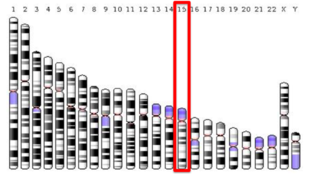
Transmembrane protein 8B is a protein that in humans is encoded by the TMEM8B gene. It encodes for a transmembrane protein that is 338 amino acids long, and is located on human chromosome 9. Aliases associated with this gene include C9orf127, NAG-5, and NGX61.

C8orf48 is a protein that in humans is encoded by the C8orf48 gene. C8orf48 is a nuclear protein specifically predicted to be located in the nuclear lamina. C8orf48 has been found to interact with proteins that are involved in the regulation of various cellular responses like gene expression, protein secretion, cell proliferation, and inflammatory responses. This protein has been linked to breast cancer and papillary thyroid carcinoma.

C9orf135 is a gene that encodes a 229 amino acid protein. It is located on Chromosome 9 of the Homo sapiens genome at 9q12.21. The protein has a transmembrane domain from amino acids 124-140 and a glycosylation site at amino acid 75. C9orf135 is part of the GRCh37 gene on Chromosome 9 and is contained within the domain of unknown function superfamily 4572. Also, c9orf135 is known by the name of LOC138255 which is a description of the gene location on Chromosome 9.1.

PRR29 is a protein encoded by the PRR29 gene located in humans on chromosome 17 at 17q23.

Uncharacterized protein C2orf73 is a protein that in humans is encoded by the C2orf73 gene. The protein is predicted to be localized to the nucleus.

Coiled-coil domain containing 74A is a protein that in humans is encoded by the CCDC74A gene. The protein is most highly expressed in the testis and may play a role in developmental pathways. The gene has undergone duplication in the primate lineage within the last 9 million years, and its only true ortholog is found in Pan troglodytes.

C15orf39 is a protein that in humans is encoded by the Chromosome 15 open reading frame 15 (C15orf39) gene.

Proline-rich basic protein 1(PROB1) is a protein encoded by the PROB1 gene located on human chromosome 5, open reading frame 65. PROB1 is also known as C5orf65 and weakly similar to basic proline-rich protein.

Transmembrane protein 171 (TMEM171) is a protein that in humans is encoded by the TMEM171 gene.

Cilia- and flagella-associated protein 299 (CFAP299), is a protein that in humans is encoded by the CFAP299 gene. CFAP299 is predicted to play a role in spermatogenesis and cell apoptosis.

C2orf16 is a protein that in humans is encoded by the C2orf16 gene. Isoform 2 of this protein is 1,984 amino acids long. The gene contains 1 exon and is located at 2p23.3. Aliases for C2orf16 include Open Reading Frame 16 on Chromosome 2 and P-S-E-R-S-H-H-S Repeats Containing Sequence.

ProteinFAM89A is a protein which in humans is encoded by the FAM89A gene. It is also known as chromosome 1 open reading frame 153 (C1orf153). Highest FAM89A gene expression is observed in the placenta and adipose tissue. Though its function is largely unknown, FAM89A is found to be differentially expressed in response to interleukin exposure, and it is implicated in immune responses pathways and various pathologies such as atherosclerosis and glioma cell expression.

Serum amyloid A-like 1 is a protein in humans encoded by the SAAL1 gene.

C6orf136 is a protein in humans encoded by the C6orf136 gene. The gene is conserved in mammals, mollusks, as well some porifera. While the function of the gene is currently unknown, C6orf136 has been shown to be hypermethylated in response to FOXM1 expression in Head Neck Squamous Cell Carcinoma (HNSCC) tissue cells. Additionally, elevated expression of C6orf136 has been associated with improved survival rates in patients with bladder cancer. C6orf136 has three known isoforms.

Family with sequence 98, member C or FAM98C is a gene that encodes for FAM98C has two aliases FLJ44669 and hypothetical protein LOC147965. FAM98C has two paralogs in humans FAM98A and FAM98B. FAM98C can be characterized for being a Leucine-rich protein. The function of FAM98C is still not defined. FAM98C has orthologs in mammals, reptiles, and amphibians and has a distant orhtologs in Rhinatrema bivittatum and Nanorana parkeri.

Zinc Finger Protein 548 (ZNF548) is a human protein encoded by the ZNF548 gene which is located on chromosome 19. It is found in the nucleus and is hypothesized to play a role in the regulation of transcription by RNA Polymerase II. It belongs to the Krüppel C2H2-type zinc-finger protein family as it contains many zinc-finger repeats.

C13orf42 is a protein which, in humans, is encoded by the gene chromosome 13 open reading frame 42 (C13orf42). RNA sequencing data shows low expression of the C13orf42 gene in a variety of tissues. The C13orf42 protein is predicted to be localized in the mitochondria, nucleus, and cytosol. Tertiary structure predictions for C13orf42 indicate multiple alpha helices.

Chromosome 13 Open Reading Frame 46 is a protein which in humans is encoded by the C13orf46 gene. In humans, C13orf46 is ubiquitously expressed at low levels in tissues, including the lungs, stomach, prostate, spleen, and thymus. This gene encodes eight alternatively spliced mRNA transcript, which produce five different protein isoforms.

C10orf53 is a protein that in humans is encoded by the C10orf53 gene. The gene is located on the positive strand of the DNA and is 30,611 nucleotides in length. The protein is 157 amino acids and the gene has 3 exons. C10orf53 orthologs are found in mammals, birds, reptiles, amphibians, fish, and invertebrates. It is primarily expressed in the testes and at very low levels in the cerebellum, liver, placenta, and trachea.

UBALD1 is a protein encoded by the UBALD1 gene, located on chromosome 16 in humans. UBALD1 has high ubiquitous tissue expression and localizes in the nucleus and cytoplasm. UBALD1 is conserved in animals, including invertebrates. An alias for UBALD1 is FAM100A.



























